The Aerostructure Market is estimated to be valued at USD 70.9 billion in 2025 and is projected to reach USD 143.5 billion by 2035, registering a compound annual growth rate (CAGR) of 7.2% over the forecast period.
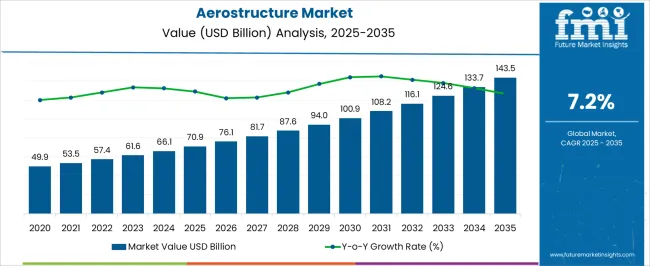
| Metric | Value |
|---|---|
| Aerostructure Market Estimated Value in (2025 E) | USD 70.9 billion |
| Aerostructure Market Forecast Value in (2035 F) | USD 143.5 billion |
| Forecast CAGR (2025 to 2035) | 7.2% |
The aerostructure market is advancing steadily, supported by increasing aircraft production, modernization of existing fleets, and rising air passenger traffic worldwide. Structural components such as wings, fuselage sections, and empennages are integral to ensuring safety, aerodynamics, and fuel efficiency.
Demand is being reinforced by growing investments in lightweight materials and advanced manufacturing techniques, including additive manufacturing and automated fiber placement. The market is influenced by both commercial and defense aviation, with emphasis on fuel-efficient aircraft to meet regulatory and sustainability requirements.
Supply chain resilience and technological innovation remain critical as manufacturers seek to reduce costs and improve production scalability. Looking ahead, growth will be driven by rising aircraft deliveries, advancements in composite material integration, and the ongoing replacement of aging fleets across global markets.

The fixed wing segment dominates the platform category, holding approximately 52.40% share of the aerostructure market. This dominance is driven by the widespread use of fixed wing aircraft in both commercial and defense sectors, supported by their efficiency in long-haul transportation and operational versatility.
The segment benefits from continuous investments in new-generation aircraft programs focused on reducing fuel consumption and emissions. High production volumes of narrow-body and wide-body aircraft have reinforced demand for fixed wing structures, particularly in regions with growing air traffic.
The integration of advanced materials and design optimization has further strengthened the segment’s role in delivering lightweight yet durable aerostructures. With increasing global air travel and fleet expansion strategies by airlines, the fixed wing segment is expected to sustain its leading position.
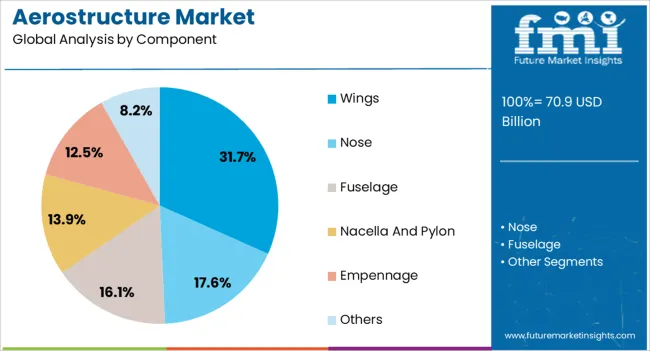
The wings segment holds approximately 31.70% share in the component category, underscoring its critical role in the aerostructure market. Wings are essential for aerodynamic efficiency, fuel storage, and housing advanced systems, making them a primary focus of design innovation.
The segment has benefited from the adoption of lightweight composites and advanced aerodynamic designs aimed at improving fuel efficiency. High demand for replacement and maintenance of wings in aging fleets further supports the segment.
Technological advancements in automated manufacturing processes have improved production scalability and quality assurance. With increasing aircraft deliveries and continuous research into wing optimization for better lift-to-drag ratios, the wings segment is projected to maintain strong growth.
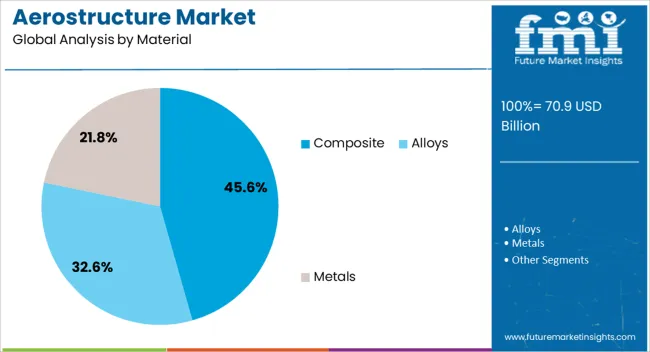
The composite segment leads the material category, accounting for approximately 45.60% share, driven by the aviation industry’s push for lightweight and fuel-efficient designs. Composites offer high strength-to-weight ratios, corrosion resistance, and design flexibility, making them ideal for critical aerostructure components such as fuselages, wings, and empennages.
The segment benefits from expanding use in both commercial and military aircraft programs, supported by advancements in composite fabrication and bonding technologies. Sustainability concerns have also accelerated composite adoption, as airlines and manufacturers seek to reduce carbon emissions.
With long-term commitments to next-generation aircraft development and increased composite integration in production, this segment is expected to remain central to the aerostructure market.
This section provides a comprehensive analysis of the industry during the last five years, highlighting the expected growth patterns in the aerostructure market. The market is progressively strangling, as shown by a strong 9.0% historical compound annual growth rate. The industry is predicted to develop steadily at a 7.3% CAGR until 2035.
| Historical CAGR | 9.0% |
|---|---|
| Forecast CAGR | 7.3% |
Global economic downturns and lessened air travel demand owing to the pandemic have affected the aerostructure industry, leading to a slowdown in the industry's growth and development.
Crucial factors are anticipated to affect the demand for aerostructures through 2035.
Market participants need to be astute and adaptable during the anticipated period, as these tough aspects position the industry for future growth.
Urban Air Mobility (UAM) Trend Skyrockets in Aerospace Sector
The rapid advancement in urban air mobility is giving rise to new transportation concepts, including electric vertical takeoff and landing (eVTOL) vehicles. These emerging trends are transforming the way people travel and posing new challenges to the design and production of aerostructures. Growing demand for urban air mobility (UAM) services is predicted to have a key effect on the expansion of the aerostructure sector.
The growth of aerostructures is attributed to the need for innovative and durable aerostructures that can withstand the unique demands of eVTOL vehicles and support the safe and efficient operation of UAM services. From advanced materials to aerodynamic design, the aerostructure industry is constantly evolving to meet the demands of urban air mobility.
Advancements in the Manufacturing Materials and Technology
The use of additive manufacturing (AM), often known as 3D printing, has allowed for more effective production and customization of aerostructures. The aerostructure and aviation industries are growing rapidly. Advanced lightweight materials like composites and alloys are gaining popularity in the industry. They enhance fuel efficiency and reduce aircraft weight, leading to increased speed, better maneuverability, and lower airline operational costs.
The aviation industry is focusing on developing lightweight materials and advanced manufacturing technologies to enhance aircraft performance and reduce environmental impact, aiming to transition toward a more eco-friendly aviation sector using sustainable materials and manufacturing processes.
The aerostructure and aviation industry is expected to experience significant growth due to advanced manufacturing techniques, lightweight materials, and the development of novel materials, which enhance aircraft performance and contribute to a sustainable future.
Increased Connectivity Influences Global Supply Chain Spirit
As sophisticated avionics and connection technologies improve passenger enjoyment, communication, and navigation, there is an increasing need for aerostructures to enable these services. Establishing resilient and varied supply chains is essential to meeting the rising demand.
This guarantees constant manufacturing of materials and aerostructure components necessary to satisfy industrial demands. The aerostructure sector is expanding primarily due to these causes, and businesses that can adjust to these shifting patterns have a favorable future in the forthcoming decade.
This section provides detailed insights into specific segments of the aerostructure industry. The research focuses primarily on two key subjects: the fixed-wing platform segment and the wings as a component segment. Through comprehensive analysis, this section aims to offer a deeper understanding of these segments and their significance in the broader context of the aerostructure industry.
| Attributes | Details |
|---|---|
| Top Platform | Fixed Wing |
| CAGR from 2025 to 2035 | 7.1% |
The fixed wing platform category is expected to dominate the aerostructure market, exhibiting a CAGR of 7.1% between 2025 and 2035. However, it is noteworthy that the CAGR for fixed wing platforms was previously projected to be a promising 8.8%. The development of fixed wings for aerostructures can be attributed to several factors:
| Attributes | Details |
|---|---|
| Top Component | Wings |
| CAGR from 2025 to 2035 | 6.8% |
The wings segment is leading in the component category, with a notable compound annual growth rate (CAGR) of 6.8%. This is a decrease from the prior CAGR of the wings component, which was 8.6% from 2020 to 2025. The following drivers describe the development of the wings component segment:

This section delves into the aerostructure markets of some of the significant nations on the global map, including the United States, China, Japan, South Korea, and the United Kingdom. Through a comprehensive analysis, explore the various factors impacting these countries' demand, acceptance, and deals with aerostructures.
The aerospace industry in the United States is expected to witness steady growth of 7.5% until 2035. Despite the moderate growth, the industry is projected to reach a valuation of USD 143.5 billion by 2035. The following factors are driving the demand for aerostructures, which plays a crucial role in the growth of the aerospace industry:
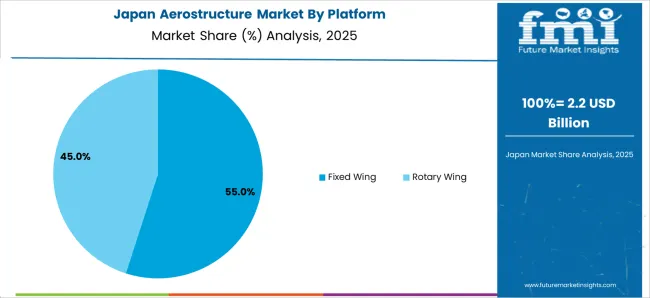
Japan's aerostructure manufacturing industry is witnessing a remarkable surge in demand. As per market analysis, the sector experience a CAGR of 8.8% through 2035, which is expected to result in a valuation of around USD 14.7 billion by the same year. It is worth noting that the previous CAGR of the Japan aerostructure market was around 12.1%. Some of the primary drivers include:
According to a recent analysis, China aerostructure market is witnessing a significant surge in demand at a predicted CAGR of 7.9%. Experts anticipate the sector to reach a valuation of USD 20.8 billion by the year 2035. The Chinese industry experienced a notable CAGR of 11.3% between 2020 and 2025. Among the main trends are:
The aerostructure market in the United Kingdom is expected to witness substantial growth in the coming years, with an estimated CAGR of 8.4% until 2035. The industry has already shown significant potential, with a CAGR of 9.7% between 2020 and 2025. The market is projected to be valued at USD 5.4 billion, indicating a vast potential for growth and investment in this sector. Here are a few of the key trends:
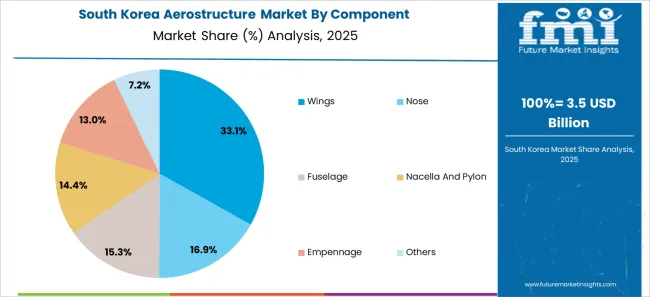
With a potential CAGR of 9.3%, the demand for aerostructure in South Korea is expected to expand at a substantial rate. By 2035, this increase is expected to decipher into a valuation of USD 49.9 billion. It should be noted that the nation has previously seen a higher CAGR of 16.0% from 2020 to 2025. Several of the key trends are as follows:
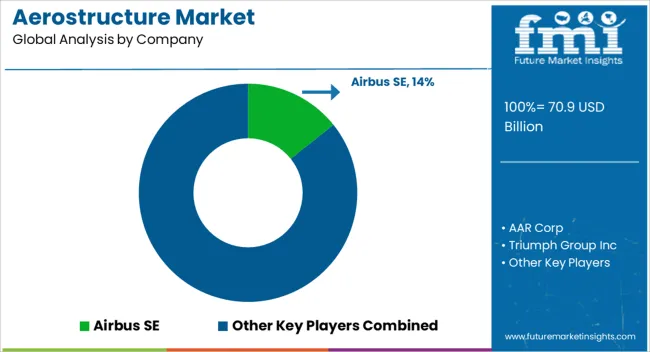
The aerostructure industry is witnessing a transformational shift as establishments leverage strategic initiatives and innovations to shape the future viewpoint. Research and development centers within aerospace companies are pioneering materials, manufacturing processes, and aerodynamics advancements. Collaborative partnerships between industry players, academia, and government entities foster a dynamic ecosystem, accelerating technological breakthroughs.
Investment in cutting-edge technologies such as additive manufacturing, digitalization, and 3D material printing transforms traditional production methods, enhancing efficiency and customization. Global partnerships enable knowledge exchange and market expansion, enabling the aerostructure industry to realize its full potential.
The aerostructure industry is also witnessing a growing emphasis on sustainable practices, which focus on eco-friendly materials and processes to align with environmental goals. Training programs and educational institutions contribute to a skilled workforce, ensuring a talent pipeline for the industry. These establishments are propelling the aerostructure sector toward a future defined by innovation and sustainability.
Recent Developments in the Aerostructure Industry:
The global aerostructure market is estimated to be valued at USD 70.9 billion in 2025.
The market size for the aerostructure market is projected to reach USD 143.5 billion by 2035.
The aerostructure market is expected to grow at a 7.2% CAGR between 2025 and 2035.
The key product types in aerostructure market are fixed wing, _commercial, _military, _business jet, _general aviation aircraft, rotary wing, _commercial helicopters, _military helicopters and _uavs.
In terms of component, wings segment to command 31.7% share in the aerostructure market in 2025.






Our Research Products

The "Full Research Suite" delivers actionable market intel, deep dives on markets or technologies, so clients act faster, cut risk, and unlock growth.

The Leaderboard benchmarks and ranks top vendors, classifying them as Established Leaders, Leading Challengers, or Disruptors & Challengers.

Locates where complements amplify value and substitutes erode it, forecasting net impact by horizon

We deliver granular, decision-grade intel: market sizing, 5-year forecasts, pricing, adoption, usage, revenue, and operational KPIs—plus competitor tracking, regulation, and value chains—across 60 countries broadly.

Spot the shifts before they hit your P&L. We track inflection points, adoption curves, pricing moves, and ecosystem plays to show where demand is heading, why it is changing, and what to do next across high-growth markets and disruptive tech

Real-time reads of user behavior. We track shifting priorities, perceptions of today’s and next-gen services, and provider experience, then pace how fast tech moves from trial to adoption, blending buyer, consumer, and channel inputs with social signals (#WhySwitch, #UX).

Partner with our analyst team to build a custom report designed around your business priorities. From analysing market trends to assessing competitors or crafting bespoke datasets, we tailor insights to your needs.
Supplier Intelligence
Discovery & Profiling
Capacity & Footprint
Performance & Risk
Compliance & Governance
Commercial Readiness
Who Supplies Whom
Scorecards & Shortlists
Playbooks & Docs
Category Intelligence
Definition & Scope
Demand & Use Cases
Cost Drivers
Market Structure
Supply Chain Map
Trade & Policy
Operating Norms
Deliverables
Buyer Intelligence
Account Basics
Spend & Scope
Procurement Model
Vendor Requirements
Terms & Policies
Entry Strategy
Pain Points & Triggers
Outputs
Pricing Analysis
Benchmarks
Trends
Should-Cost
Indexation
Landed Cost
Commercial Terms
Deliverables
Brand Analysis
Positioning & Value Prop
Share & Presence
Customer Evidence
Go-to-Market
Digital & Reputation
Compliance & Trust
KPIs & Gaps
Outputs
Full Research Suite comprises of:
Market outlook & trends analysis
Interviews & case studies
Strategic recommendations
Vendor profiles & capabilities analysis
5-year forecasts
8 regions and 60+ country-level data splits
Market segment data splits
12 months of continuous data updates
DELIVERED AS:
PDF EXCEL ONLINE

Thank you!
You will receive an email from our Business Development Manager. Please be sure to check your SPAM/JUNK folder too.
Chat With
MaRIA